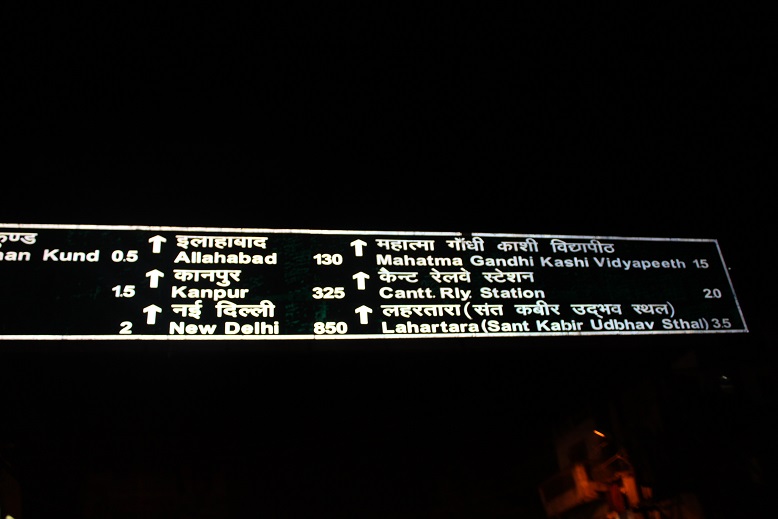
If you are just now joining my pilgrimage, take time to go back and read where I have been so far…At this time we are leaving Khajuraho and heading for Agra via Delhi. Being “less Bohemian” than my friend Jane, I convinced her we should hire a car and driver to take us to Agra from the Delhi airport instead of maneuvering the train/train station at night.
So after a little “misunderstanding with our driver” (no bait and switch, thank you), we were on our way. I guess it is quite common that you make a deal with one driver and then they go negotiate with another driver who is not working for maybe half the money. That way the original driver makes money, but can then turn around and make more, and the driver that isn’t working can have some work. Whatever, we did not like that, and demanded the guy we agreed would drive us hold to his agreement.
Our next little obstacle was when our driver asked us if we wanted to go the “fast” or the “slow” route. I told him we had agreed on the fast route. He said we had just paid for the slow route. Well needless to say we weren’t happy and complained and asked that he call his boss and we were going to have a discussion. Supposedly the fast route included toll roads and really was much faster. We finally agreed to pay the extra price, and he agreed to throw in a guide and driver the next day in Agra. We said that would be okay with us as we knew if we did not like the guide, we would have our hotel get us someone else.
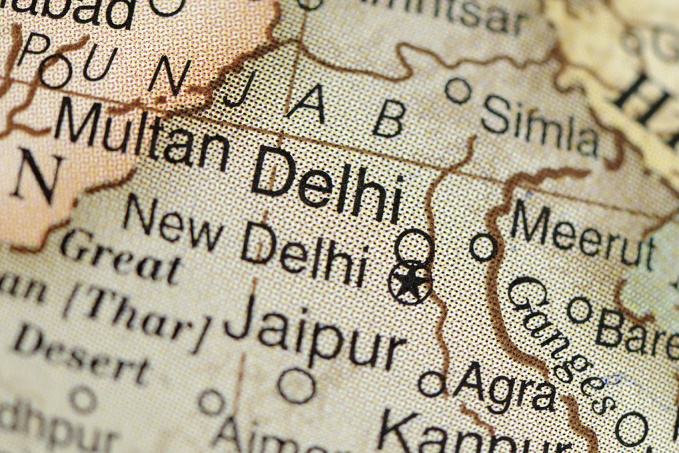
We were so tired and in a few hours arrived in Agra at our hotel where our guide for tomorrow was waiting for us! He seemed like he would be great and so we only needed to decide what time he would meet us in the morning. I was thinking like 10am and Jane said absolutely not, she wanted to get up really early so we could be there at sunrise! I said I did not think it would make any difference but was out-voted by both Jane and the guide. She really wanted to go early so I agreed as hard as it was! I had been so hot for so long the idea of sleeping in a room with air-conditioning until I naturally woke up was the only thing on my mind tonight.
A little history of Agra
The history of Agra before the Muslim conquest is shrouded in obscurity. The only reference to it is one by the Persian poet, Salman, who died in 1131, A.D. It is stated that Mahmud so ruined Agra, which had been a great Hindu strong hold since the days of Kans (the tyrant ruler of the Vrishni kingdom), that it did not recover. In the great epic, Mahabharat, there is a reference to Agraban and this may well be Agra.
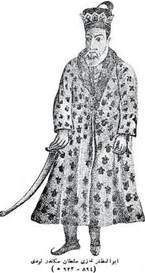
Sikandar Lodi who made Agra his capital in the year 1501 A.D., built a fort and laid out a city. He rebuilt his new capital after it was destroyed by an earthquake within a year of its foundations. Though none of the buildings in the city can be assigned to him, his name is preserved in the suburb of Sikandra, where he erected a baradari (a building or pavilion with 12 doors designed to allow free flow of air) which is still standing. It was after his death that Babar, the first of the Great Mughals, continued to live at Agra and made it a city of gardens. Ram Bagh and Zohra Bagh (both are gardens) are all that remain today.
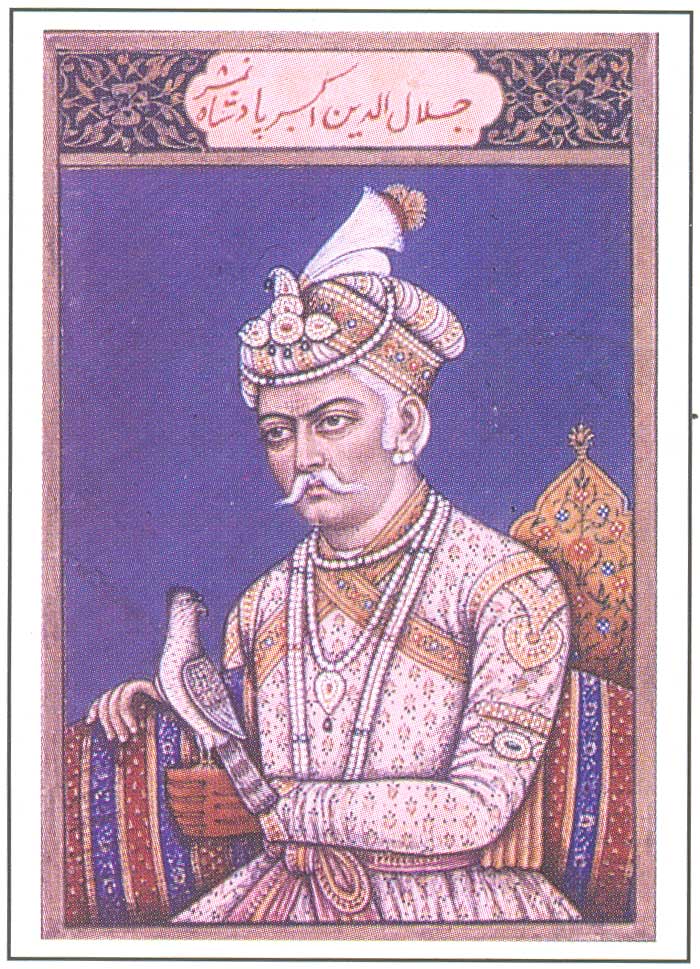
Agra rose to prominence during the reign of Akbar. He build the Fort and made Agra the seat of one of the mightiest and richest kingdoms. From the years 1570 to 1885, he shifted his capital to Fatehpur Sikri, now a deserted city lying twenty seven miles south-west of Agra.
It was, however, in the seventeenth century, during the reign of Shah Jahan, grandson of Akbar, that Agra reached the peak of its glory as the city of immortal architecture. This period found expression in a style of architecture of exceptional splendor carried to the highest degree of perfection. Shah Jahan built much of the Fort, most the buildings of the city and the Taj-it was an age of marble culminating in its excellence in the Taj Mahal. Sandstone was replaced by marble in its most refined form. Sha Jahan resided here from 1632 to 1637 and renamed the city Akbarbad. The name however did not endure.
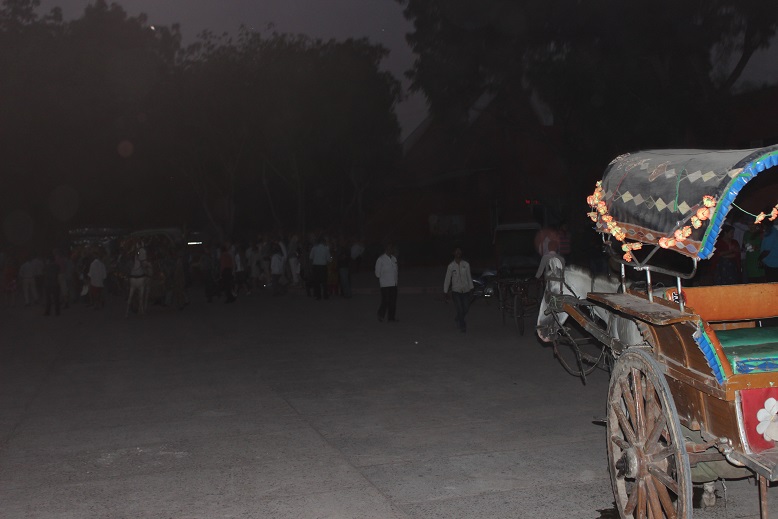
It seemed like we had slept for only an hour when it was time to get up and head for the Taj Mahal. It was still dark when Zeeshan, our guide, met us at the front desk of our hotel. We walked a ways to get to the ticket office.
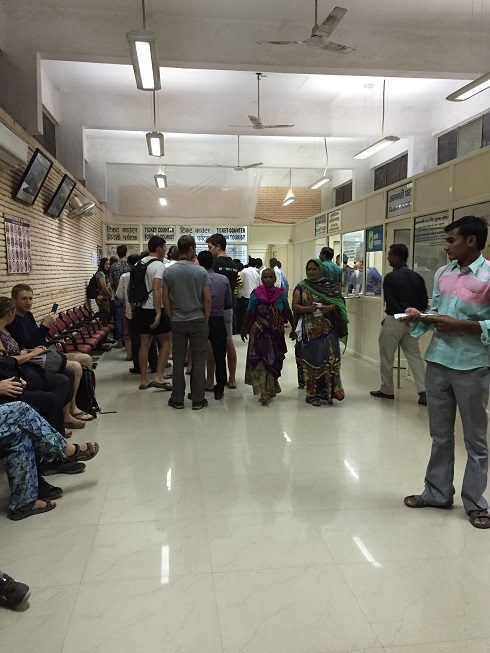
We waited while Zeeshan bought our tickets. The office was very busy and full of young men working as guides. I was still so tired, but as the sun began to come up, my excitement began to arise. I was still thinking 10am would have been just great!
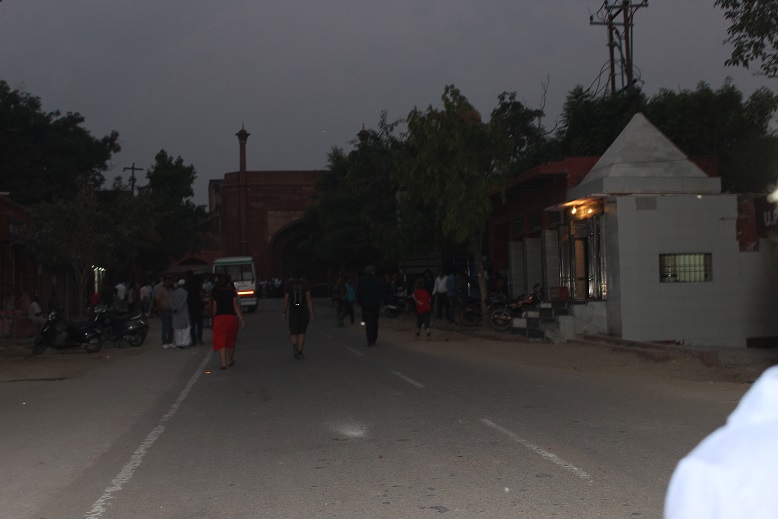
As we got closer to the main gate, we could see how long the lines were. Zeeshan said he would try to find a quicker way to get us through but thought it might be easier to take us in one at a time. So I waited in line until he was successful getting Jane in and then he came back and got me.
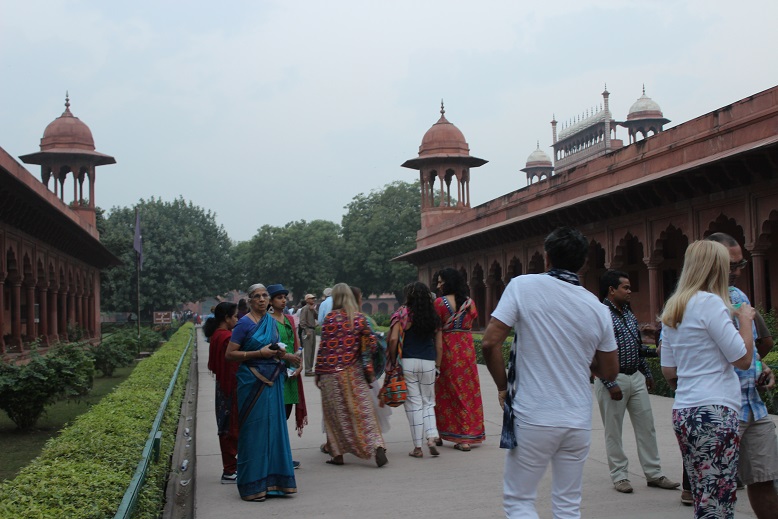
He said it really wasn’t too crowded yet, but would be soon since sunrise was the most popular time to visit the Taj Mahal. I asked why and he said it had to do with the color of the marble different times of the day!
For every hour of the day and for every atmospheric condition, the Taj has its own color values, from the soft dreaminess at dawn, and the dazzling whiteness at midday to its cold splendor in the moonlight. Yet none of these effects can equal those few fleeting moments when, softly illuminated by the brief Indian afternoon, it assumes the enchanting tint of some pale and lively rose. “
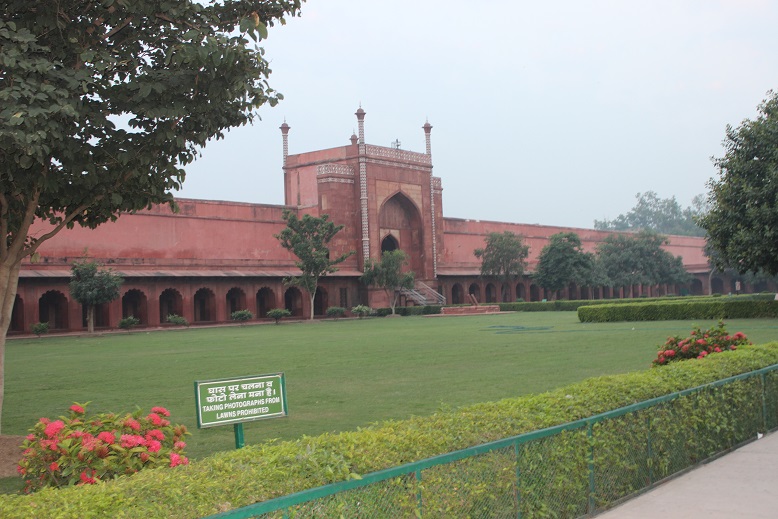
Once we got in the entrance gate, we were still not in the main gates. The grounds were beautiful and very well kept!
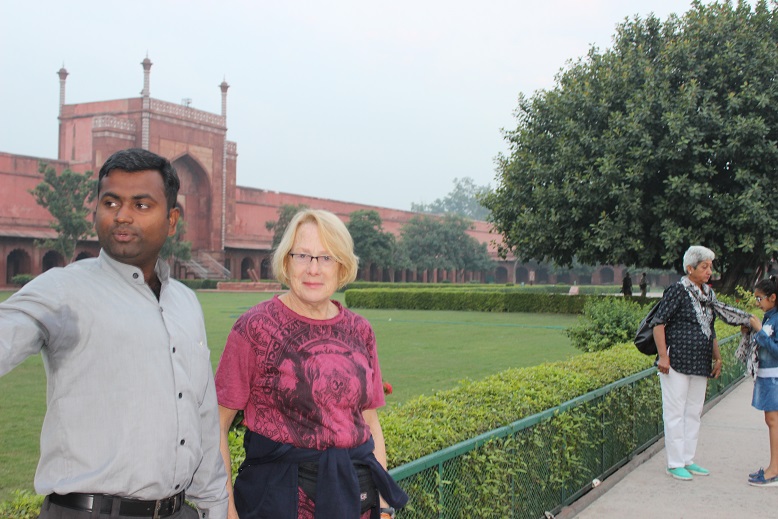
Here Jane and Zeeshan pose for a picture on the way the to the main gate.
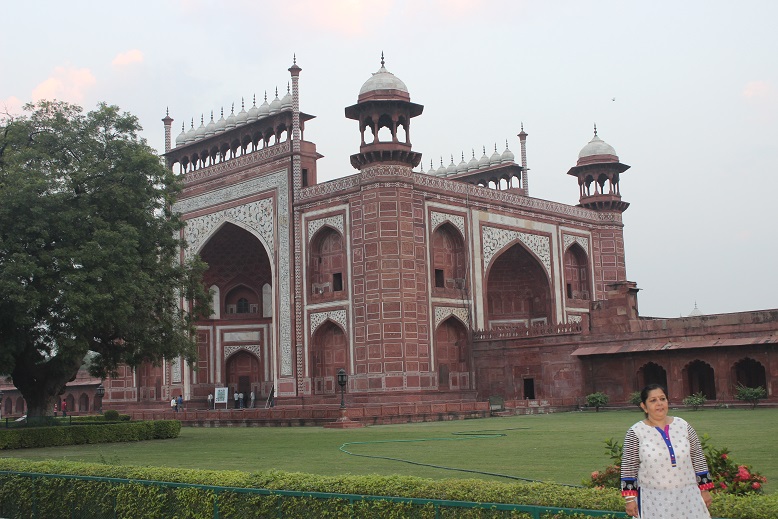
The Western Gate is the main entrance of the Taj Mahal and this gate faces towards the Agra cantonment and Agra city. There is a red sand stone edifice outside this gate which is known as Fatehpuri Masjid, which was constructed in the memory of Fatehpuri Begum another wife of Shah Jahan. It is erected on a beautiful terrace.
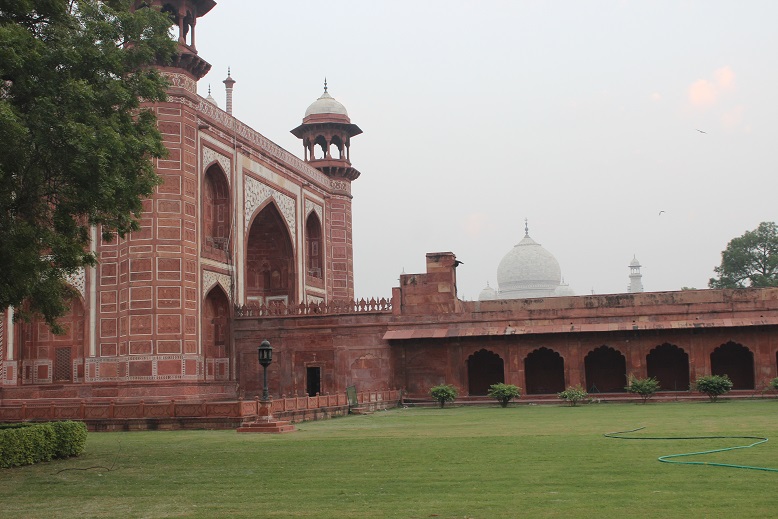
We were being teased by the Taj in the distance and like all these famous places in India, it takes a long time once you are on the grounds to actually get the the main event. So many gardens!
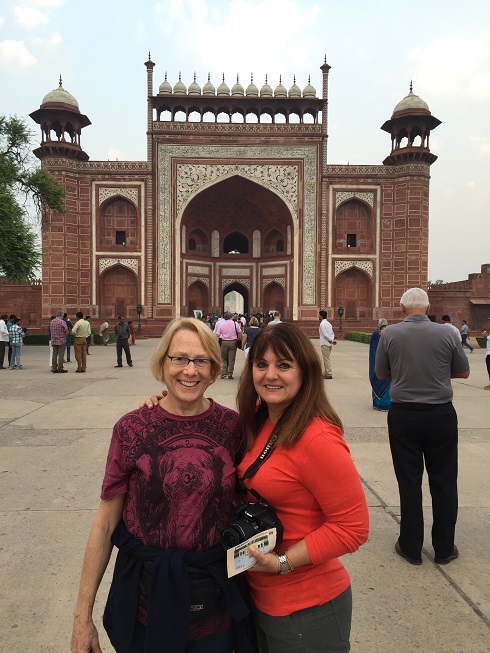
Of course Jane and I had to have our picture taken in front of the Main Gate!
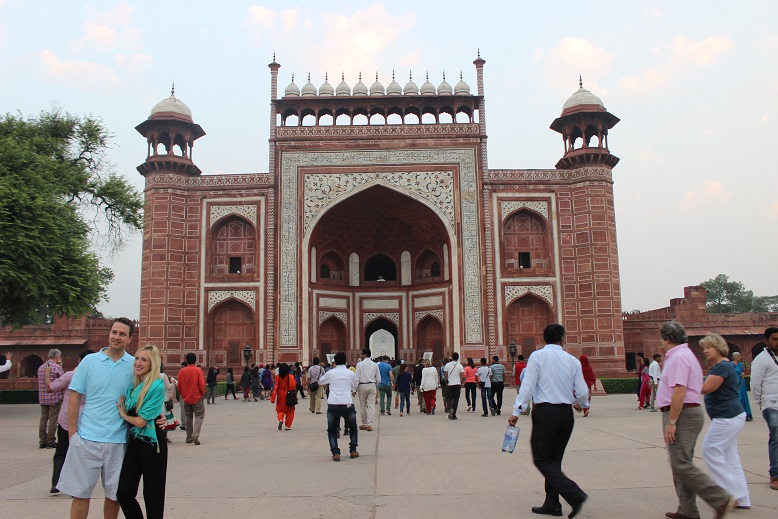
You can see as the sun rises, the number of tourist’s increases quickly! The gates themselves are magnificent.
After entering the huge gate, there is a beautiful tomb of Situ-nu-Nisa Khanam on the left side. She was the personal and favorite maid companion of Mumtaz Mahal. She was also the governess of Jahan Ara Begum the beloved daughter of Shah Jahan, who spent her days and lonely nights with her father. Situ-nu-Nisa was a child less widow and after the death of Mumtaz Mahal, she had gone to Lahore. She dies in the year 1648 A. D. in Lahore and after her death, her body was brought to Agra in 1749 A D. to be buried in the Taj complex as per the last wish of Mumtaz. The tomb is beautifully paved with marble. In the center hall of this dome, the grave of Situ-un-Nisa is situated with beautiful and colorful paintings on the walls and the ceiling.
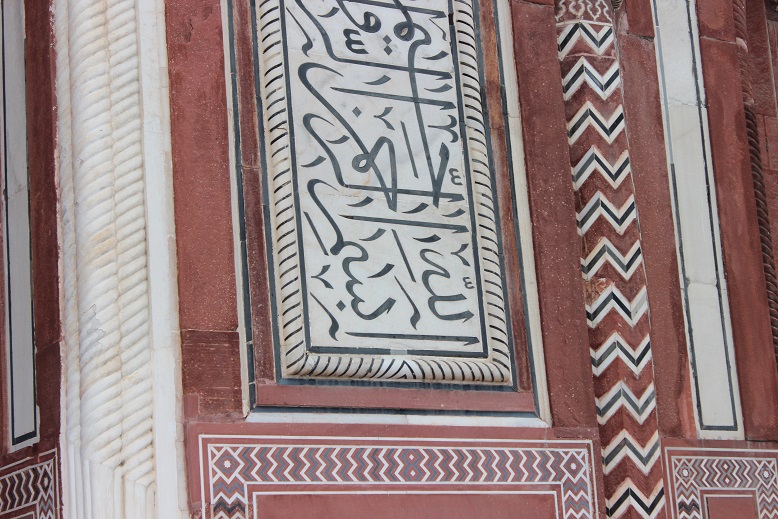
The Gate Way of Taj is an octagonal entrance hall, surrounded by small rooms on both sides in the floors having beautifully ornamented gates on two sides, one opening towards the court yard side and the other towards the Mausoleum itself. On the three sides of this gateway, there are strong balconies. The gate is a masterpiece fine inlay work in itself. The profuse inlay work of white marble and precious stones into the red sandstone surface, has elegantly executed inscriptions in “Thulth“ script, inlayed with black marble on white marble surface, giving a charming look to the whole structure. Some Quranic texts are nicely inscribed in black letters. These Quranic verses do not appear bigger at the bottom than they are at the top. On the top there is a row of white marble cupolas and the corners are crowned by open domed kiosks.
The calligraphy on the Great Gate reads “O Soul, thou art at rest. Return to the Lord at peace with Him, and He at peace with you.”. Much of the calligraphy is composed of florid thuluth script, made of jasper or black marble, inlaid in white marble panels. Higher panels are written in slightly larger script to reduce the skewing effect when viewed from below. The calligraphy found on the marble cenotaphs in the tomb is particularly detailed and delicate.
There are also two other gates. The southern Gate is towards the South, which faces the old Mumtazabad. It is meant for the pedestrians or the peddlers only. On the right side of this gate is a Tomb of red stone which is surrounded by courtyards and crowned with a dome. It is said that there is a grave of one lady companion of Mumtaj Mahal. Due to this reason this building is called as the tomb of a Maid of Honor.
Eastern Gate faces towards Fatehabad. There is a domed tomb erected on an elevated platform near this gate. This tomb was built in the memory of another wife of Shah Jahan called Sirhindi Begum. Due to this, the gate is known as Sirhi Darwaza. The main building is eight sided having twenty four arches, a big hall, and a verandah.
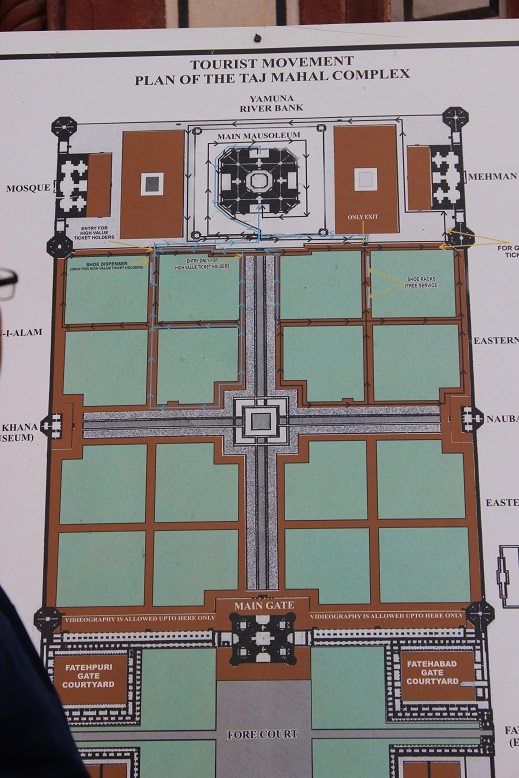
Here is a map of the grounds. A very typical layout showing the gardens, waterways and buildings.
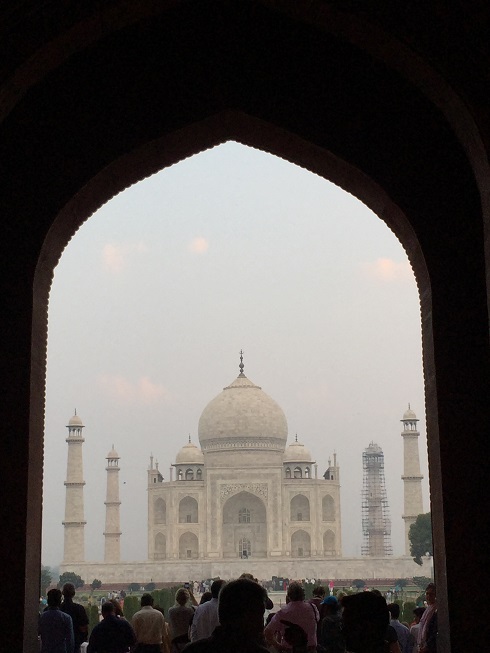
We walked a little further and there she was. The Taj Mahal. Taj aptly called a “dream in marble” is situated on the right banks of the Yamuna River. It is towards the South of the city and is a distance of about three kms. The Taj Mahal, the most beautiful building in the world, is made of white marble in the loving memory of the then Empress of India-named Arjumand Bano Begum. She was the granddaughter of Mirza Giyas Beg-who was later known as Itamad ud-Daula and who was the father of Noor Jahan, the wife of Prince Salim of Jahangir. The name of her father was Khwaja Abul Hasan entitled as Yamin-ud Daula. Asaf Khan, who was real brother of Noor Jahan and was the Prime Minister of Jahangir’s court. She was Persian by blood and was born on 6th April 1593 A. D. She was very beautiful-like Noor Jahan, from her early childhood and was liked by Noor Jahan very much. Her father arranged for her education in a royal manner and she developed in her all the qualities and merits of a royal family. Prince Khurram was only sixteen years old when he fell in love with Asaf Khan’s daughter, Arjuman Bano Begum, later known as Mumtaz Mahal.
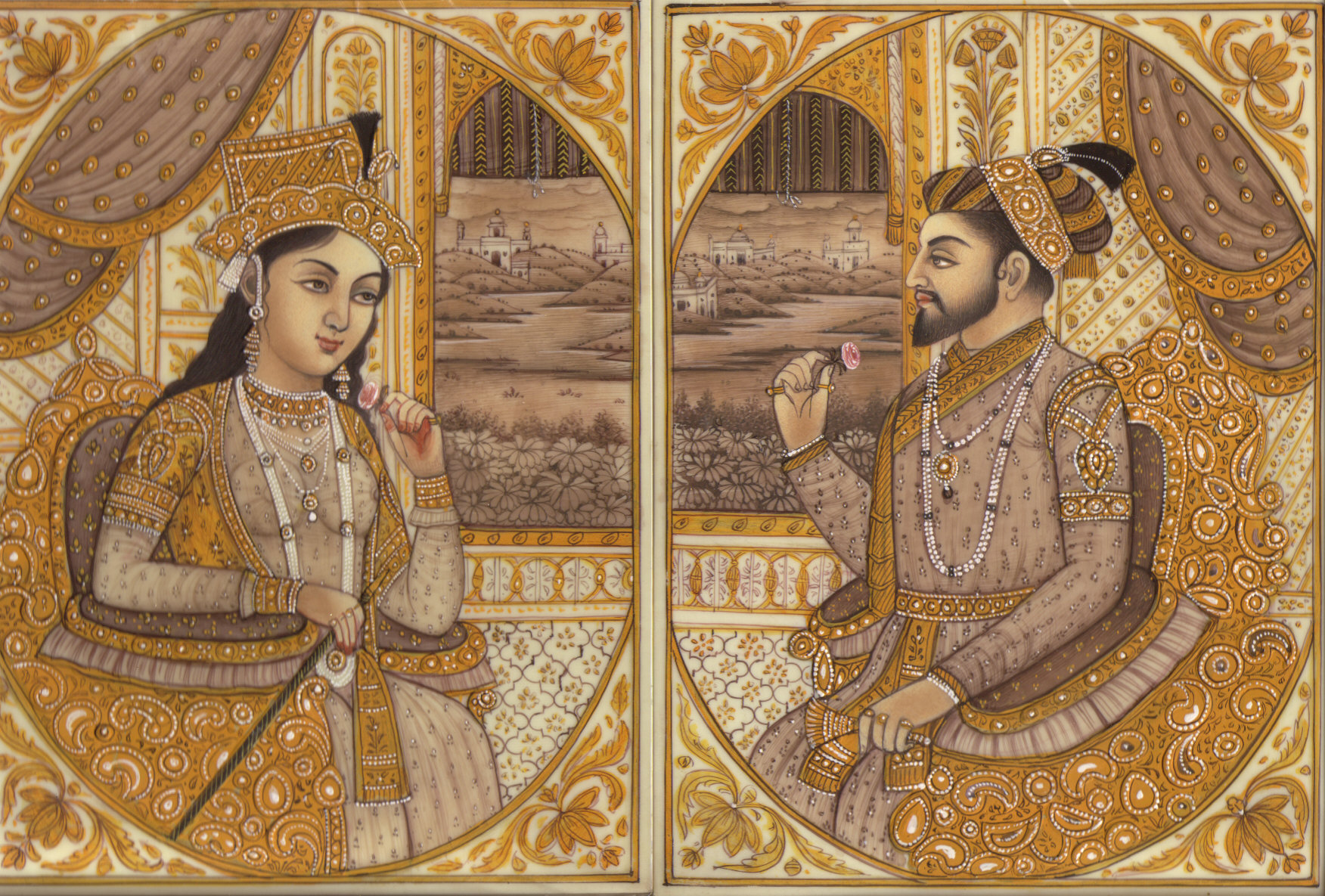
Shah Jahan and Mumtaz Mahal first met at the Meena Bazaar, a weekly market held in the palace every Friday. Here, the women from noble families would set up stalls for the pleasure of their male buyers from the royal family.
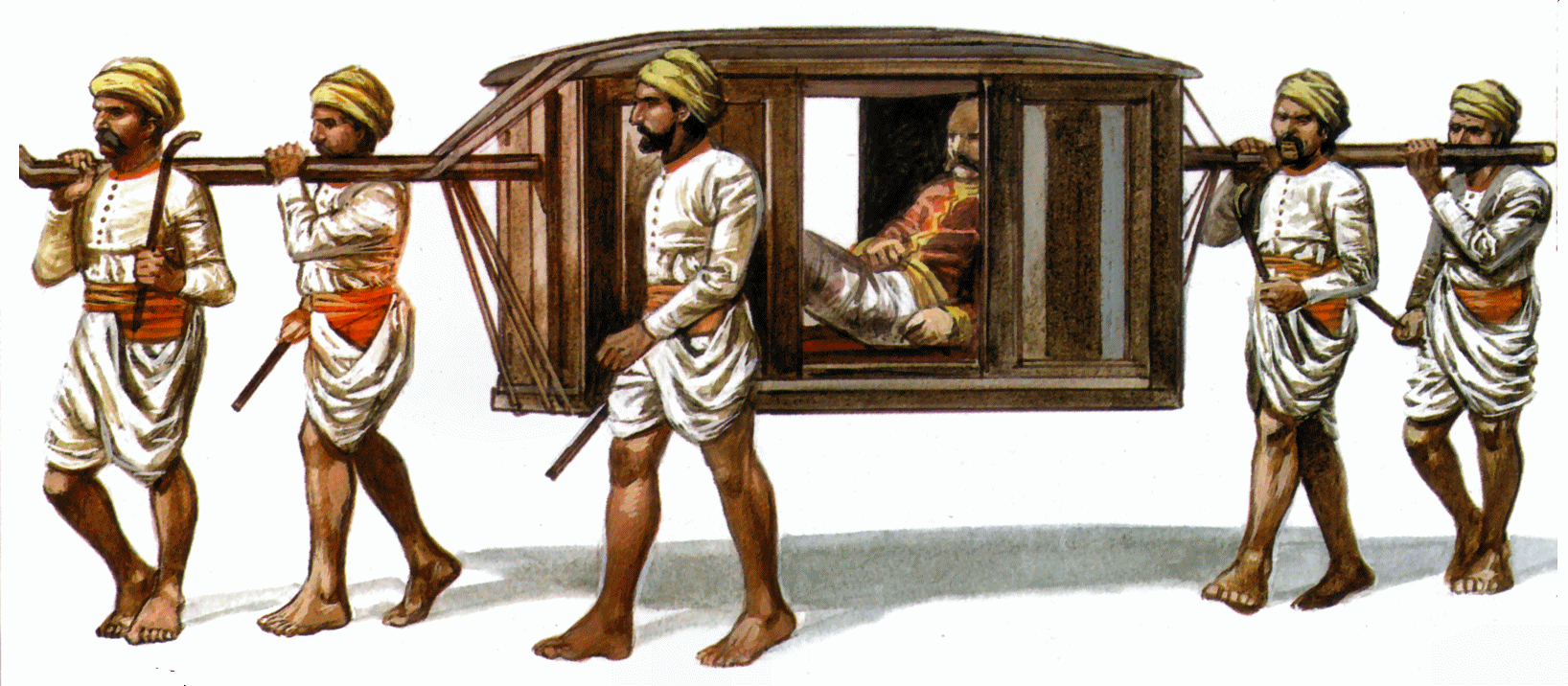
Shah Jahan, then known as Prince Khurram, was being carried in a palanquin (as shown above) by four Tartar women slaves when he stopped before a stall where a young girl was selling mishri, crude sugar crystals. The prince picked up a piece and asked the price. The girl flirtatiously quoted an astronomical amount. Showing no surprise, the prince paid up in gold coins. Seeing the prince mistake the mishri for a diamond, the girl started laughing and her veil was uncovered to reveal her face. Mesmerized by his stepmother’s niece, he vowed to make her his bride. They were married in 1612 when he was twenty and she was nineteen. In all, she gave birth to fourteen children, averaging one child every sixteen months. Of these, only four boys and three girls survived. Mumtaz Mahal died four years after Shah Jahan’s accession to the throne, during the birth of her fourteenth child, in 1631. At that time she was camping with Shah Jahan in Burhanpur. She accompanied the emperor on all his travels and pregnancy did not prevent her from undertaking these journeys, no matter how arduous. It was in the early hours of the morning of June 17, 1631 that a hemorrhage caused during the birth of her third daughter, Gauhara Begum, resulted in her death. When news of the queen’s condition reached Shah Jahan, he rushed to her side, but it was clear that the empress would not revive. Kneeling beside her he asked her if there was anything he could do for her. There was, said the dying empress. She made him promise that he would not have any more children from his other wives and that he would build a tomb over her grave that would be so beautiful, it would remind coming generations of the story of their love. As the empress closed her eyes, a last teardrop slipped out from her beautiful eyes and caressed her cheek. The grief-stricken emperor removed the teardrop from his beloved’s face and eventually built her a mausoleum that looked as though it was-“An eternal teardrop, Descending from the heavens, On the cheek of time”.
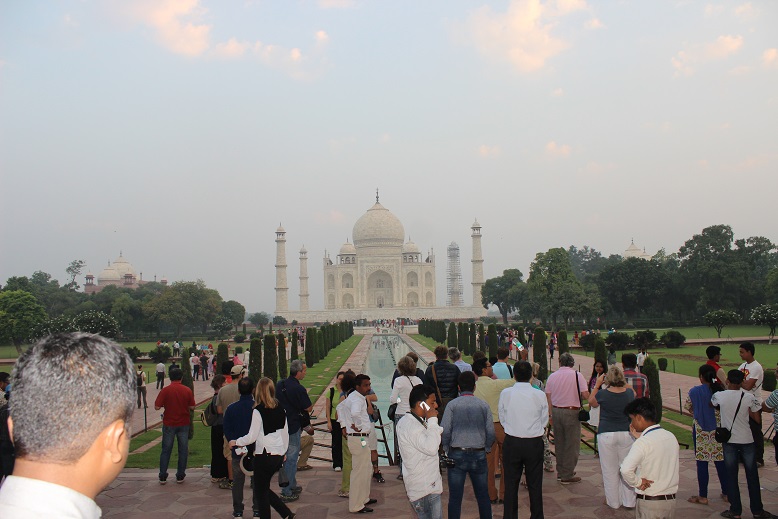
Mumtaz Mahal’s body was bathed with cold camphor and rosewater by female bearers and wrapped in five pieces of cloth. Four close relatives carried the body to the burial site. She was temporarily buried in a garden on the banks of the river Tapti, two yards below the earth, her body aligned from north to the south with the face turned west toward the holy city of Mecca. Shah Jahan mourned for forty days. He wore only white. His hair too turned white. He would often visit her grave at night and cry there till the wee hours of the morning. He would hardly eat or listen to music. He refused to enter the women’s quarters that would remind him of her. For two years, Shah Jahan was a broken man.
After six months, he had her body transported to Agra, close to the site where she would finally lie. The garden where her tomb was to be built was bought from the Maharaja of Jaipur. The body was buried, again temporarily, in the North West corner of the garden close to the mosque. The final blueprint for the tomb was drawn by leading architects of the empire. Mir Abad al-Karim and Makramat Khan. Ustad Ahmad Lahori is another name connected with many of the Shah Jahan’s buildings. The final plan was submitted to Shah Jahan for his approval. After work on it began, sixteen years were to pass before the main building was ready and another five before the garden and courtyard were completed. Twenty thousand workers, artisans and master-craftsman worked on the site. A township called Mumtazabad sprang up around the site. Some fifteen hundred elephants transported the white marble blocks, each weighing a ton and a half, to the site. Large numbers of Brahmi bulls were used to transport the raw material. The marble quarries were located in Makrana, 140 miles west of Agra. Red sandstone was brought from Fatehpur Sikri. A 2.5 mile long ramp was constructed to transport the marble blocks to the top of the building. Architecturally, the Taj Mahal represents the epitome of the Mughal architecture. It is a synthesis of Hindu and Islamic building traditions. It is certainly the most symmetrical of all Mughal buildings. A walled garden with four water channels is a representation of paradise or Pari Darwaza, abode of the angels. Since Islam as a religion took birth in the desert state of Saudi Arabia, water and gardens are closely associated with heaven. The sacred color for Muslims is also green. The pietra dura inlay on the surface of the marble too reflects the idea of the garden of paradise.
Shah Jahan’s own crypt is the only thing asymmetrical in the Taj Mahal. Initially, there was no plan to place his crypt within the building. It is said that he intended to build another Taj Mahal, this one in black marble, on the opposite bank of the river. He then intended to connect them with two bridges, one white, and the other black.
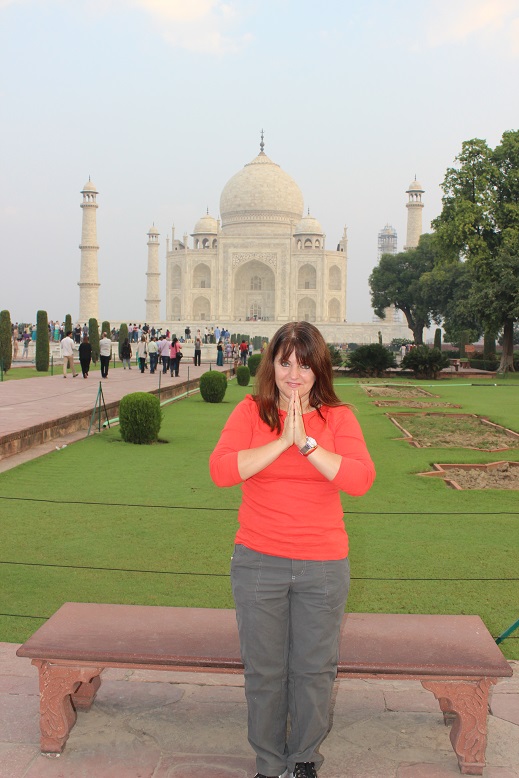
Of course we had to pose for the official tourist pictures in the garden.
The garden that starts from the end of the main gateway and ends near the squared base of the mausoleum is an integral part of the Taj Mahal structure and is, undeniably, one of the major highlights of the visit for many. The garden that beautifies Taj comes from the Persian Timurid style of gardens, and is based on the concept of paradise garden’ and was brought in by Babur. This garden, filled with flowers, fruits, birds, leaves, symmetry, and delicacy, served many functions along with portraying strong symbolic or abstract meanings about paradise. A paradise which, according to Islamic beliefs, consists of four rivers: one of water, one of milk, one of honey, and one of wine. And it is from this concept that Char Bagh of Taj Mahal originated. Also, the symbolism of the garden and its division are noted in the Islamic texts that describe paradise as a garden filled with abundant trees, flowers, and plants.
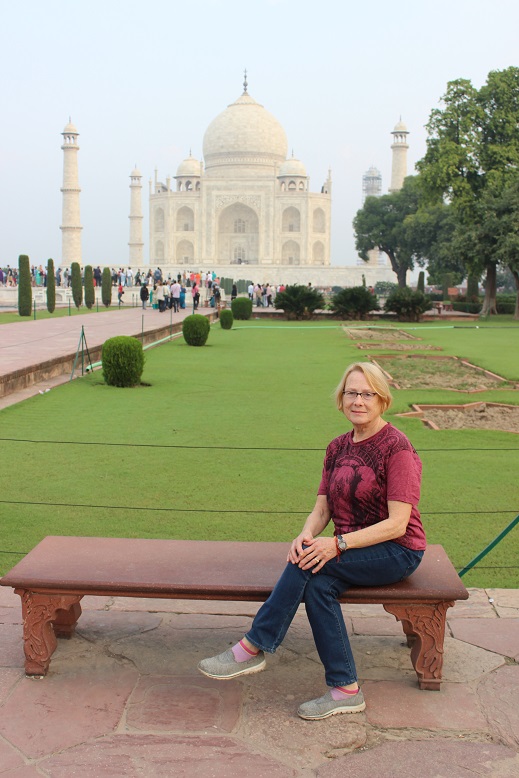
Jane looks right at home. (So happy she insisted we visit early as the Taj was just beautiful as it reflected the morning sky).
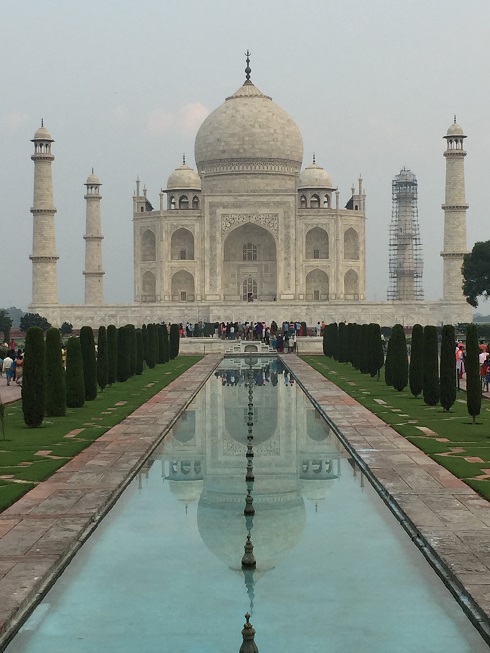
Here is the best picture I took. I did this with my IPhone 6, can you believe it!
Fountains and running channels of water with large reservoirs are typical of their garden deigns. Water was drawn up from the river Yamuna by a system of buckets, dipping into the river and conveying water up by a chain way, drawn by the bullocks or the by camel power. The river water was collected in some big reservoirs on the top of the rooms situated in the middle of the garden walls on both the sides of the Taj enclosure. From these artificial reservoirs on the walls, water was taken through iron pipes to the fountains and the running water channels.
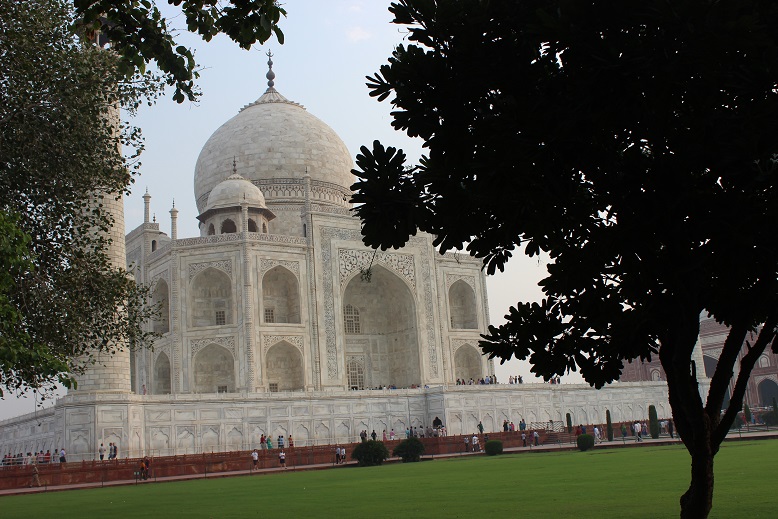
As we walked around the side to follow the visitor flow correctly, these trees just begged to be a frame.
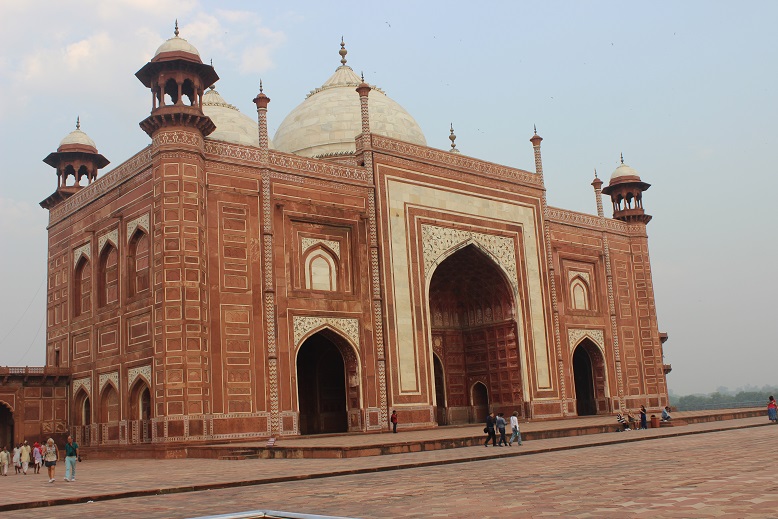
The mausoleum is flanked by two almost identical buildings on either side of the platform. To the west is the Mosque, to the east is Jawab. The Jawab, meaning ‘answer’ balances the bilateral symmetry of the composition and was originally used as a place for entertaining and accommodation for important visitors. It differs from the mosque in that it lacks a mihrab, a niche in a mosque’s wall facing Mecca, and the floors have a geometric design, while the mosque floor was laid out with the outlines of 569 prayer rugs in black marble.
The mosque’s basic tripartite design is similar to others built by Shah Jahan, particularly the Masjid-i-Jahan Numa in Delhi — a long hall surmounted by three domes. Mughal mosques of this period divide the sanctuary hall into three areas: a main sanctuary with slightly smaller sanctuaries to either side. At the Taj Mahal, each sanctuary opens onto an enormous vaulting dome.
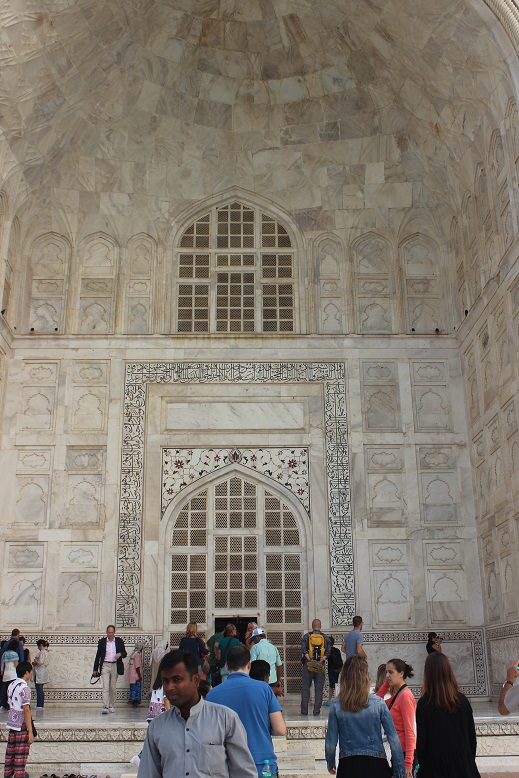
We were now ready to enter the main building. Because the Taj Mahal is a tomb, pictures were not allowed inside.
Taj tombs or graves of the Empress Mumtaz Mahal and Emperor Shah Jahan, are situated in the centric below the main dome. (picture from Taj tourist book)
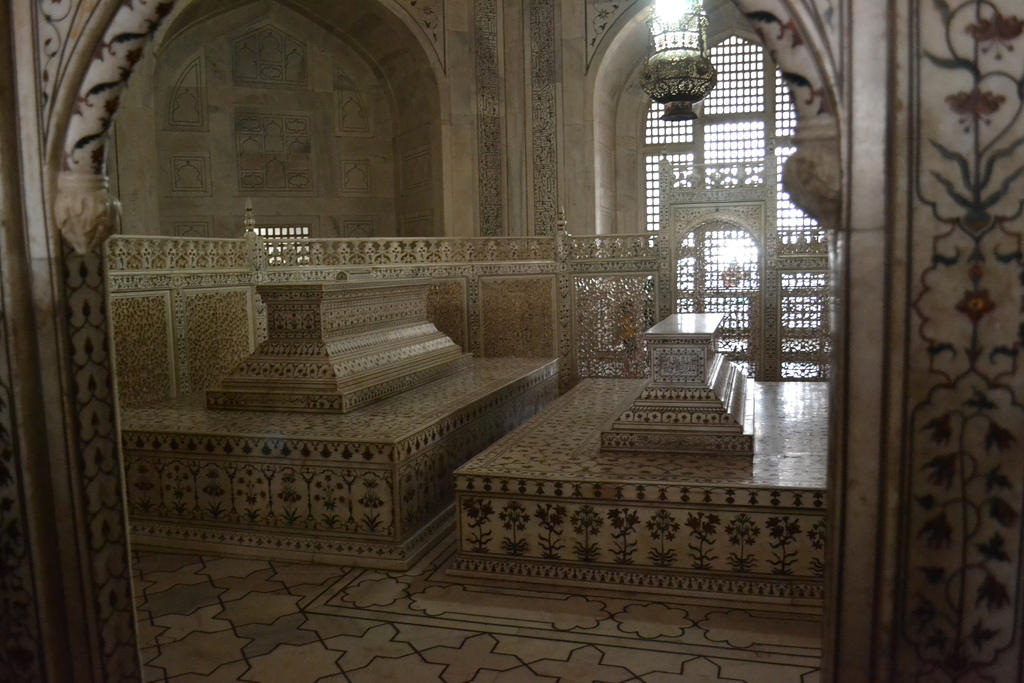
Around the cenotaphs, there is a beautiful screen an enclosure of eight sides, 6.25 feet high and each side of the screen being 12.5 ft. in length. A gold and silver railing surrounded the tomb of Mumtaz Mahal. The tomb, in accordance with Muslim tradition, was covered by woven pearls. The doors were made of pure silver with nails of gold. Precious stones imported from all over the world were inlaid in the white marble. The illumination came from silver lamps. The air was thick and perfumed with exotic fragrances from silver and gold incense burners. For the maintenance of the Taj, the revenue earned from 31 villages was fixed and a sum of Rs 2,000,000 collected annually.
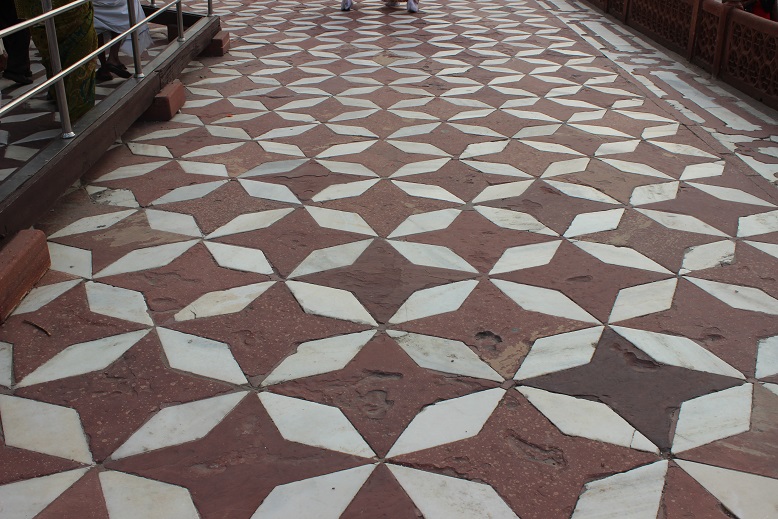
There were a few examples of some of the beautiful craftsmanship outside the Taj Mahal that could give you some type of idea how beautiful it was inside like this marble and red sandstone walkway.
Abstract forms are used throughout, especially in the plinth, minarets, gateway, mosque, jawab and to a lesser extent, on the surfaces of the tomb. The domes and vaults of the sandstone buildings are worked with tracery of incised painting to create elaborate geometric forms.
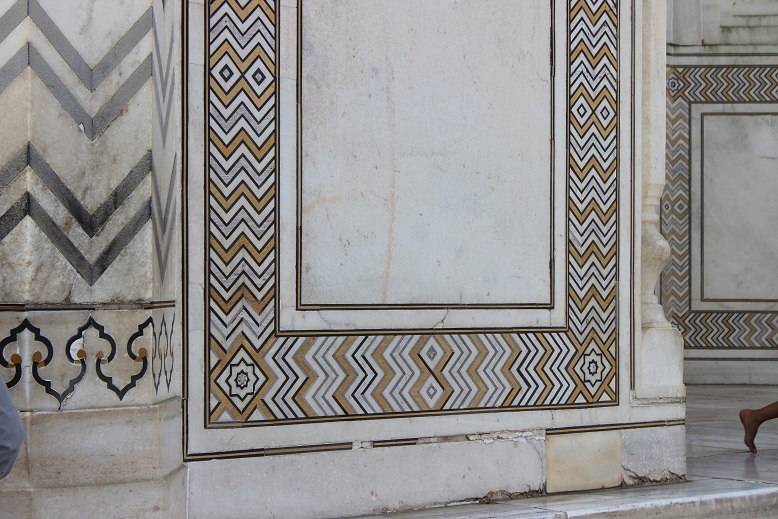
Herringbone inlays define the space between many of the adjoining elements. White inlays are used in sandstone buildings, and dark or black inlays on the white marbles. Mortared areas of the marble buildings have been stained or painted in a contrasting colour, creating geometric patterns of considerable complexity. Floors and walkways use contrasting tiles or blocks in tessellation patterns.
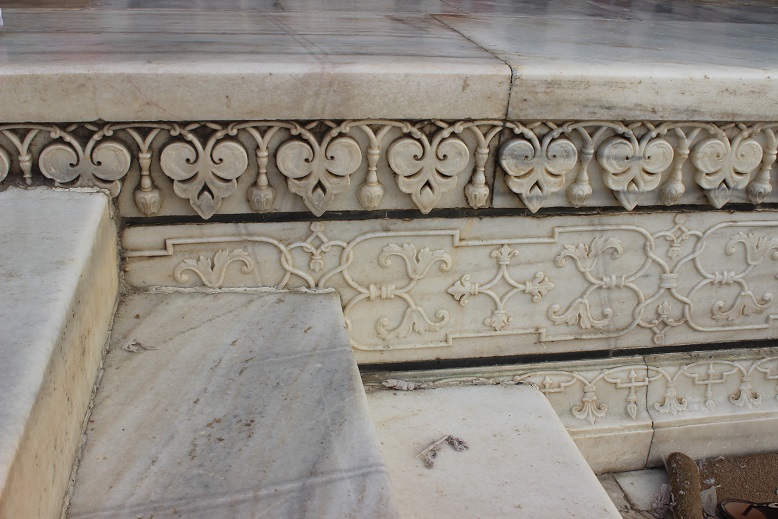
On the lower walls of the tomb there are white marble dados that have been sculpted with realistic bas relief depictions of flowers and vines. The marble has been polished to emphasize the exquisite detailing of the carvings and the dado frames and archway spandrels have been decorated with pietra dura inlays of highly stylized, almost geometric vines, flowers and fruits. The inlay stones are of yellow marble, jasper and jade, polished and leveled to the surface of the walls.
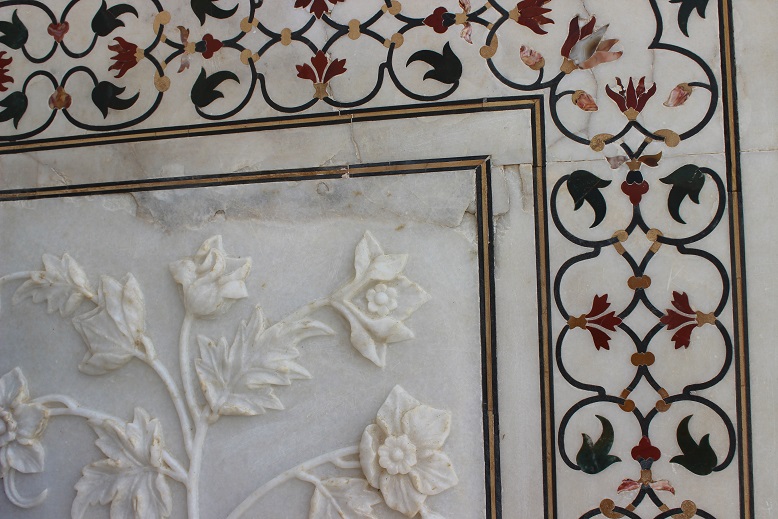
The Taj is a perfect fusion of Indian and Persian architecture. It is worth mentioning here that Ustad Isa and his pupil Ustad Ahmad Paras were of Persian origin but both of them were Indian at the same time as they were converted to Islam. Thus it may be said that the exterior of the Taj is Persian yet the soul in it is, Indian. It is established act that the designers and architects of the Taj were knowing Hindu Shilpa-Shastra.
It is a historical well-known fact, that the Mughal Emperors were under Hindu influence as had established matrimonial relations with the Hindu. The mothers of Jahangir-Jodhabai and that of Shah Jahan was the daughter of Raja Udai Singh of Marwar. Thus the imperial mothers had a full influence upon their children-the future emperors of India. Taj Mahal, with it’s for corer minarets and the main building in the middle, is of the Panch-Prasda type, and is purely Indian.
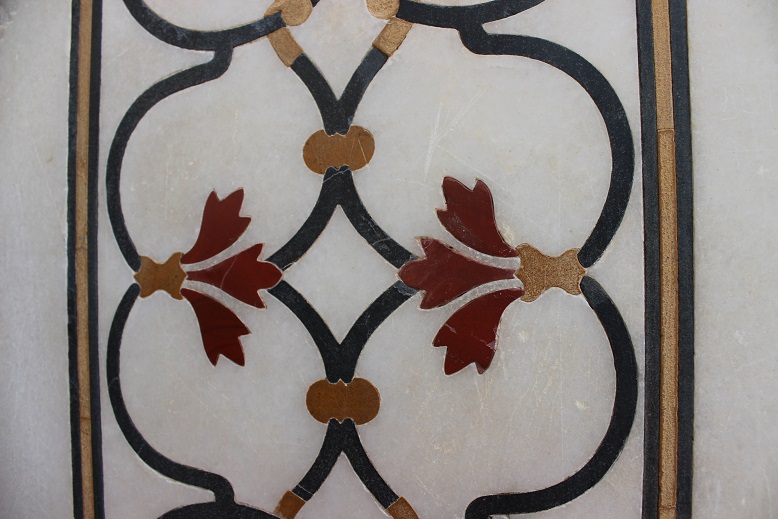
Precious jewels were inlaid into the marble. In fact at one point as we visited inside where no camera’s were to be used, Zeeshan turned the flashlight of his phone on so that we could see up close how the jewels themselves shined in the light and quickly the guards were there to confiscate his phone. Even though he was not taking pictures, they had strict rules. It took an hour or so and a few rupees to get his phone back (as well as his guide license). It seemed a little extreme to me, but Zeeshan was very professional and did everything he could (under extreme stressful conditions) to make Jane and I feel as though it was not a big deal!
To imagine that each of these pieces first had to be cut, then the white marble had to be carved out to create space, then each of these inlaid one at a time was mindboggling. There had to have been millions of these pieces inlaid in the walls and floors.
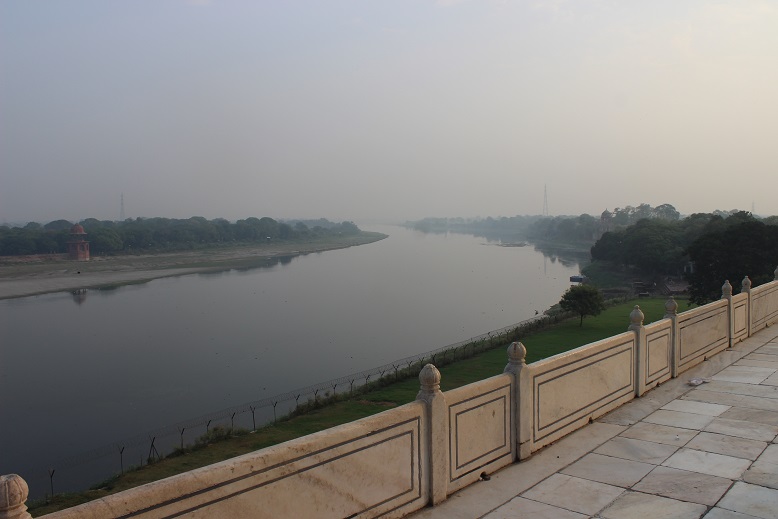
This picture was taken out the back side of the Taj Mahal. Across the river I could imagine the “black Taj Mahal” Shah Jahan wanted to build.
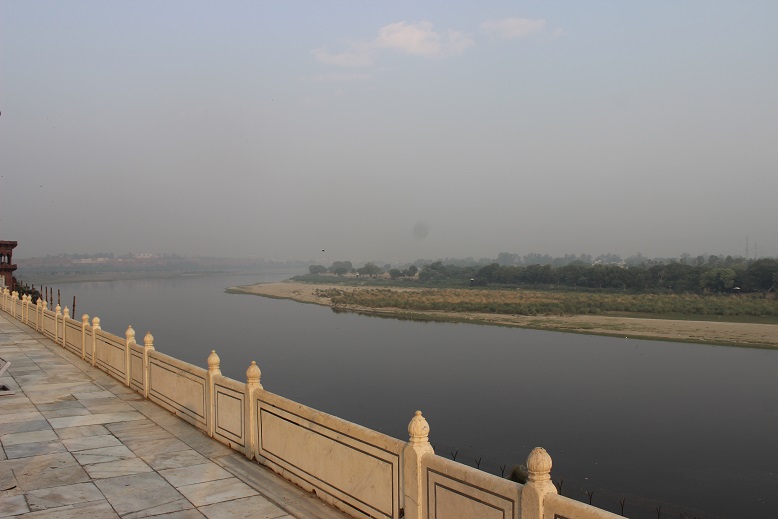
Unfortunately, Aurangzeb, Shah Jahan’s youngest son, led a rebellion against his father and had his brothers killed. He had the emperor imprisoned in the palace of Agra and had himself crowned emperor of Hindustan.
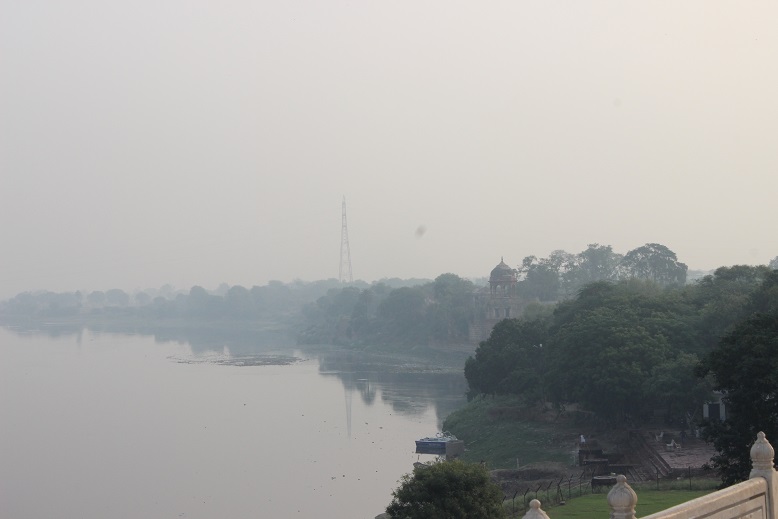
To think this very spot had been so carefully selected and then so beautifully executed with buildings and gardens, all to honor the women he loved.
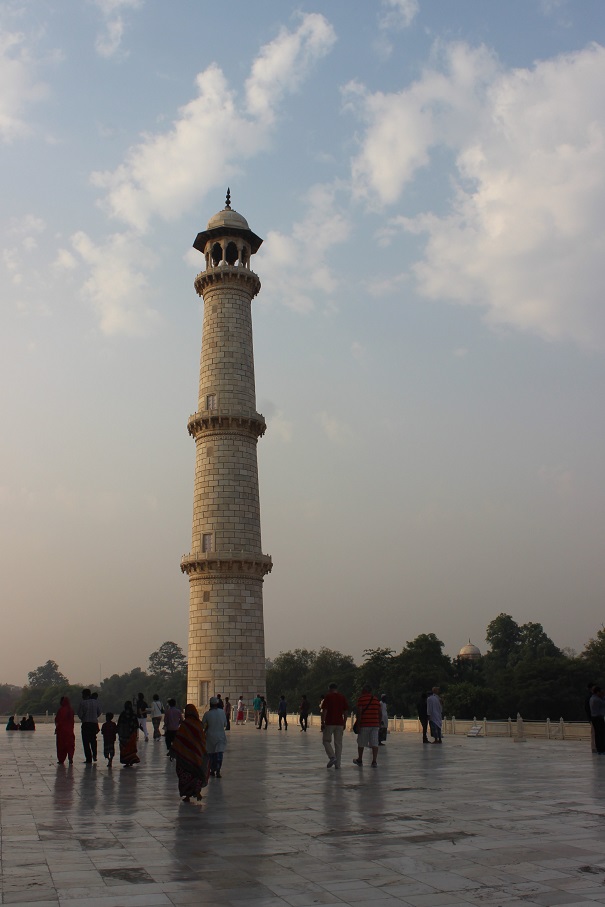
The four minarets on each corner of this square are detached, facing the chamfered angles of the main and are deliberately kept at 137 feet to emphasize the beautiful and spherical dome that itself is 58 feet in diameter and 81 feet high.
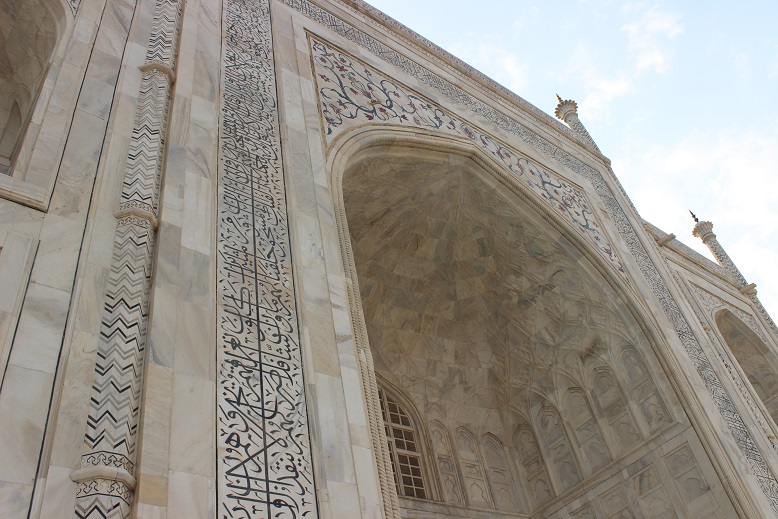
As we were beginning to leave, I had to take one more picture of the beautiful calligraphy on the outside to the main building.
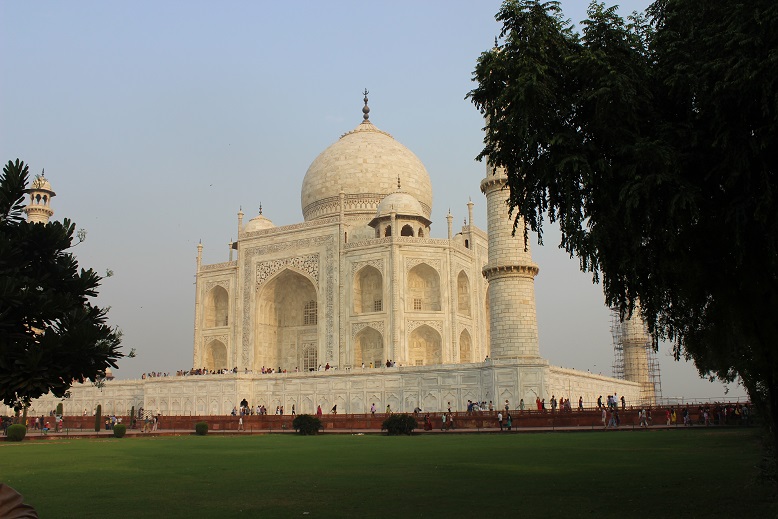
No matter what angle I shot from, the pictures showed just another angle of magnificence
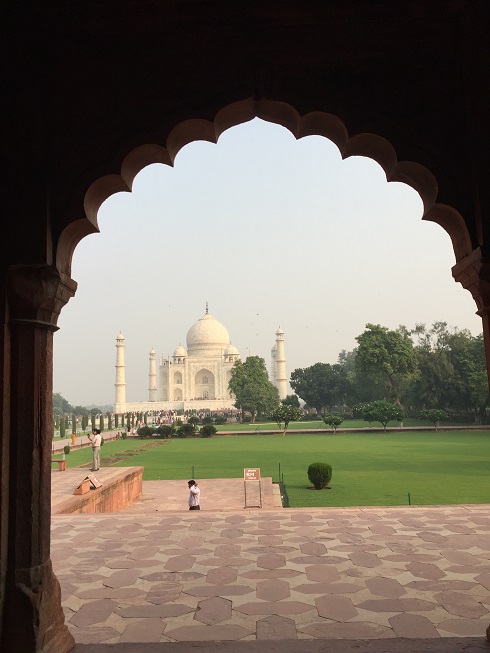
Zeeshan said to us as we were walking out, “Turn around one last time. When you walk through the gates you will no longer be able to see her.”
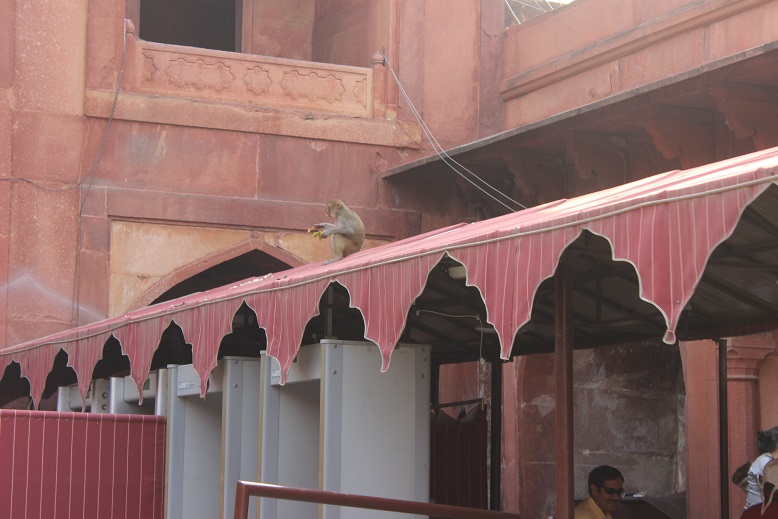
Jane and I walked pretty much in silence, still in awe, exhausted from the experience. This monkey on the roof caught our eye and we laughed as if it was the monkey that shook us back to reality.
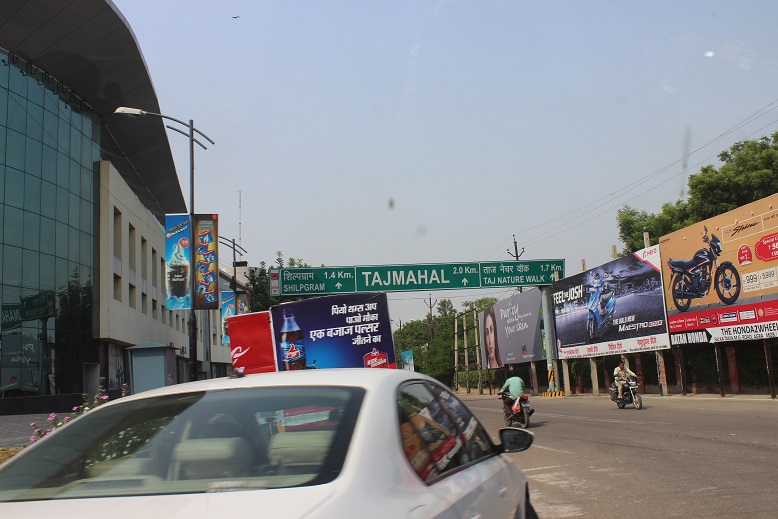
As we walked away and found a pony cart to take us back to our hotel, we saw this sign. We had missed it this morning in the dark. TAJMAHAL is what Agra is all about.
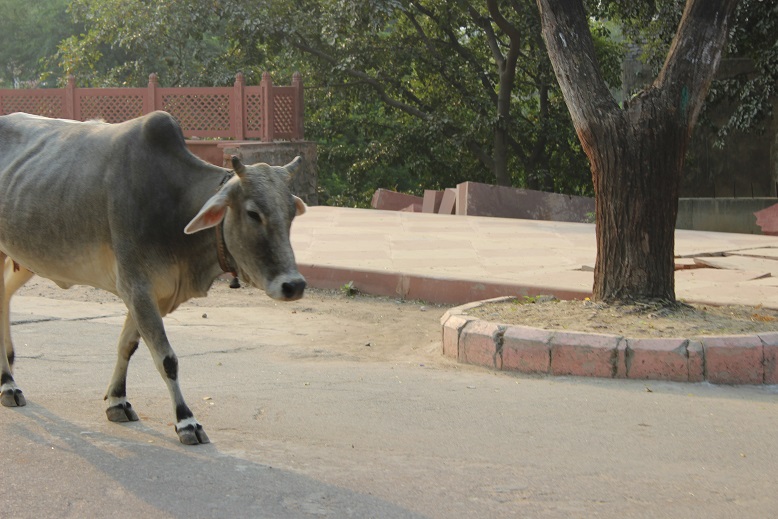
Then on to our next site, Agra Fort.
Thanks for reading and sharing…Namaste, Peggy
